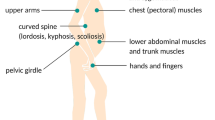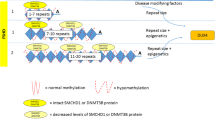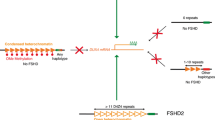Abstract
Facioscapulohumeral muscular dystrophy (FSHD), an autosomal dominant neuromuscular disorder, has been causally related to deletion of tandemly arrayed 3.3 kb repeats (D4Z4) on chromosome 4q35. Although increased expression of several 4q35 genes has been reported, two recent studies dispute this, finding no significant changes in the transcriptional level of any of the 4q35 genes, among which is the heart and muscle-specific isoform of the adenine nucleotide translocator (ANT1). We found markedly increased levels of ANT1 protein in both unaffected and affected FSHD muscles in comparison to control healthy muscles. Comparative protein expression analysis between healthy, Duchenne muscular dystrophy, and FSHD muscle shows that proteins involved in mitochondrial function and protection from oxidative stress are also reproducibly and specifically modified in all FSHD muscles, including clinically unaffected muscles. Increased ANT1 expression and mitochondrial dysfunction may thus be initial events in FSHD pathogenesis and represent potential therapeutic targets.



Similar content being viewed by others
Abbreviations
- 2-DE :
-
Two-dimensional gel electrophoresis
- ANT :
-
Adenine nucleotide translocator
- DMD :
-
Duchenne muscular dystrophy
- FSHD :
-
Facioscapulohumeral muscular dystrophy
- MALDI-TOF :
-
Matrix-assisted laser desorption/ionization time-of-flight mass spectrometry
- PAGE :
-
Polyacrylamide gel electrophoresis
- pI :
-
Isoelectric point
- ROS :
-
Reactive oxygen species
- SDS :
-
Sodium dodecyl sulfate
- SOD :
-
Cu/Zn superoxide dismutase
References
Munsat T (1994) Facioscapulohumeral dystrophy and the scapuloperoneal syndrome. In: Engel AG, Banker BQ (eds) Myologie. McGraw-Hill, New York, pp 1220–1232
Gilbert JR, Stajich JM, Speer MC, Vance JM, Stewart CS, Yamaoka LH, Samson F, Fardeau M, Potter TG, Roses AD et al (1992) Linkage studies in facioscapulohumeral muscular dystrophy (FSHD). Am J Hum Genet 51:424–7
Nakagawa M, Higuchi I, Yoshidome H, Isashiki Y, Ohkubo R, Kaseda S, Iwaki H, Fukunaga H, Osame M (1996) Familial facioscapulohumeral muscular dystrophy: phenotypic diversity and genetic abnormality. Acta Neurol Scand 93:189–192
Nakagawa M, Matsuzaki T, Higuchi I, Fukunaga H, Inui T, Nagamitsu S, Yamada H, Arimura K, Osame M (1997) Facioscapulohumeral muscular dystrophy: clinical diversity and genetic abnormalities in Japanese patients. Intern Med 36:333–339
Lunt PW, Compston DA, Harper PS (1989) Estimation of age dependent penetrance in facioscapulohumeral muscular dystrophy by minimising ascertainment bias. J Med Genet 26:755–760
Mathews KD, Mills KA, Bosch EP, Ionasescu VV, Wiles KR, Buetow KH, Murray JC (1992) Linkage localization of facioscapulohumeral muscular dystrophy (FSHD) in 4q35. Am J Hum Genet 51:428–431
Sarfarazi M, Wijmenga C, Upadhyaya M, Weiffenbach B, Hyser C, Mathews K, Murray J, Gilbert J, Pericak-Vance M, Lunt Pet al (1992) Regional mapping of facioscapulohumeral muscular dystrophy gene on 4q35: combined analysis of an international consortium. Am J Hum Genet 51:396–403
Upadhyaya M, Osborn M, Maynard J, Altherr M, Ikeda J, Harper PS (1995) Towards the finer mapping of facioscapulohumeral muscular dystrophy at 4q35: construction of a laser microdissection library. Am J Med Genet 60:244–251
Weiffenbach B, Bagley R, Falls K, Hyser C, Storvick D, Jacobsen SJ, Schultz P, Mendell J, Willems van Dijk K, Milner EC et al (1992) Linkage analyses of five chromosome 4 markers localizes the facioscapulohumeral muscular dystrophy (FSHD) gene to distal 4q35. Am J Hum Genet 51:416–423
Winokur ST, Schutte B, Weiffenbach B, Washington SS, McElligott D, Chakravarti A, Wasmuth JH, Altherr MR (1993) A radiation hybrid map of 15 loci on the distal long arm of chromosome 4, the region containing the gene responsible for facioscapulohumeral muscular dystrophy (FSHD). Am J Hum Genet 53:874–880
Wijmenga C, Padberg GW, Moerer P, Wiegant J, Liem L, Brouwer OF, Milner EC, Weber JL, van Ommen GB, Sandkuyl LA et al (1991) Mapping of facioscapulohumeral muscular dystrophy gene to chromosome 4q35-qter by multipoint linkage analysis and in situ hybridization. Genomics 9:570–575
Lee JH, Goto K, Matsuda C, Arahata K (1995) Characterization of a tandemly repeated 3.3-kb KpnI unit in the facioscapulohumeral muscular dystrophy (FSHD) gene region on chromosome 4q35. Muscle Nerve 2:6–13
van Deutekom JC, Wijmenga C, van Tienhoven EA, Gruter AM, Hewitt JE, Padberg GW, van Ommen GJ, Hofker MH, Frants RR (1993) FSHD associated DNA rearrangements are due to deletions of integral copies of a 3.2 kb tandemly repeated unit. Hum Mol Genet 2:2037–2042
Wijmenga C, van Deutekom JC, Hewitt JE, Padberg GW, van Ommen GJ, Hofker MH, Frants RR (1994) Pulsed-field gel electrophoresis of the D4F104S1 locus reveals the size and the parental origin of the facioscapulohumeral muscular dystrophy (FSHD)-associated deletions. Genomics 19:21–26
Lunt PW, Jardine PE, Koch M, Maynard J, Osborn M, Williams M, Harper PS, Upadhyaya M (1995) Phenotypic-genotypic correlation will assist genetic counseling in 4q35-facioscapulohumeral muscular dystrophy. Muscle Nerve 2:103–109
Lunt PW, Jardine PE, Koch MC, Maynard J, Osborn M, Williams M, Harper PS, Upadhyaya M (1995) Correlation between fragment size at D4F104S1 and age at onset or at wheelchair use, with a possible generational effect, accounts for much phenotypic variation in 4q35-facioscapulohumeral muscular dystrophy (FSHD). Hum Mol Genet 4:951–958
Tawil R, Forrester J, Griggs RC, Mendell J, Kissel J, McDermott M, King W, Weiffenbach B, Figlewicz D (1996) Evidence for anticipation and association of deletion size with severity in facioscapulohumeral muscular dystrophy. The FSH-DY Group. Ann Neurol 39:744–748
Gabriels J, Beckers MC, Ding H, De Vriese A, Plaisance S, van der Maarel SM, Padberg GW, Frants RR, Hewitt JE, Collen Det al (1999) Nucleotide sequence of the partially deleted D4Z4 locus in a patient with FSHD identifies a putative gene within each 3.3 kb element. Gene 236:25–32
Tupler R, Perini G, Pellegrino MA, Green MR (1999) Profound misregulation of muscle-specific gene expression in facioscapulohumeral muscular dystrophy. Proc Natl Acad Sci USA 96:12650–12654
Gabellini D, Green MR, Tupler R (2002) Inappropriate gene activation in FSHD: a repressor complex binds a chromosomal repeat deleted in dystrophic muscle. Cell 110:339–348
Winokur ST, Chen YW, Masny PS, Martin JH, Ehmsen JT, Tapscott SJ, van der Maarel SM, Hayashi Y, Flanigan KM (2003) Expression profiling of FSHD muscle supports a defect in specific stages of myogenic differentiation. Hum Mol Genet 12:2895–2907
Jiang G, Yang F, van Overveld PG, Vedanarayanan V, van der Maarel S, Ehrlich M (2003) Testing the position-effect variegation hypothesis for facioscapulohumeral muscular dystrophy by analysis of histone modification and gene expression in subtelomeric 4q. Hum Mol Genet 12:2909–2921
Laoudj-Chenivesse D, Marin P, Bennes R, Tronel-Peyroz E, Leterrier F (2002) High performance two-dimensional gel electrophoresis using a wetting agent Tergitol (R) NP7. Proteomics 2:481–485
Shevchenko A, Jensen ON, Podtelejnikov AV, Sagliocco F, Wilm M, Vorm O, Mortensen P, Boucherie H, Mann M (1996) Linking genome and proteome by mass spectrometry: large-scale identification of yeast proteins from two dimensional gels. Proc Natl Acad Sci USA 93:14440–14445
Bauer MK, Schubert A, Rocks O. Grimm S (1999) Adenine nucleotide translocase-1, a component of the permeability transition pore, can dominantly induce apoptosis. J Cell Biol 147:1493–1502
Sandri M, El Meslemani AH, Sandri C, Schjerling P, Vissing K, Andersen JL, Rossini K, Carraro U, Angelini C (2001) Caspase 3 expression correlates with skeletal muscle apoptosis in Duchenne and facioscapulo human muscular dystrophy. A potential target for pharmacological treatment? J Neuropathol Exp Neurol 60:302–312
Packer L (1995) Oxidative stress and aging, Birkhauser, Basel
Halliwell B, Gutteridge JMC (1989) Free radicals in biology and medecine. Clarenton, Oxford, pp 86–135
Giometti CS, Anderson NG (1981) Muscle protein analysis. III. Analysis of solubilized frozen-tissue sections by two-dimensional electrophoresis. Clin Chem 27:1918–1921
Giometti CS (1982) Muscle protein analysis by two-dimensional gel electrophoresis. Crit Rev Clin Lab Sci 18:79–109
Giometti CS, Danon MJ, Anderson NG (1983) Human muscle proteins: analysis by two-dimensional electrophoresis. Neurology 33:1152–1156
Giometti CS, Gemmell MA, Anderson NL (1985) Two different variants of the same tropomyosin polypeptide in clones from GM1386 human skin fibroblasts. Biochem Biophys Res Commun 128:1247–1253
Giometti CS, Danon MJ (1990) The expression of myosin light chains and tropomyosin in human muscle biopsies with histochemical type 1 and type 2 fiber deficiency. Muscle Nerve 13:209–214
van Overveld PG, Lemmers RJ, Sandkuijl LA, Enthoven L, Winokur ST, Bakels F, Padberg GW, van Ommen GJ, Frants RR, van der Maarel SM (2003) Hypomethylation of D4Z4 in 4q-linked and non-4q-linked facioscapulohumeral muscular dystrophy. Nat Genet 35:315–317
Yan LJ, Sohal RS (1998) Mitochondrial adenine nucleotide translocase is modified oxidatively during aging. Proc Natl Acad Sci USA 95:12896–12901
Wallace DC, Brown MD, Melov S, Graham B, Lott M (1998) Mitochondrial biology, degenerative diseases and aging. Biofactors 7:187–190
Wallace DC, Melov S (1998) Radicals r’aging. Nat Genet 19:105–106
Chance B, Sies H, Boveris A (1979) Hydroperoxide metabolism in mammalian organs. Physiol Rev 59:527–605
Zorov DB, Filburn CR, Klotz LO, Zweier JL, Sollott SJ (2000) Reactive oxygen species (ROS)-induced ROS release: a new phenomenon accompanying induction of the mitochondrial permeability transition in cardiac myocytes. J Exp Med 192:1001–1014
Wang P, Chen H, Qin H, Sankarapandi S, Becher MW, Wong PC, Zweier JL (1998) Overexpression of human copper, zinc-superoxide dismutase (SOD1) prevents postischemic injury. Proc Natl Acad Sci USA 95:4556–4560
Merad-Saidoune M, Boitier E, Nicole A, Marsac C, Martinou JC, Sola B, Sinet PM, Ceballos-Picot I (1999) Overproduction of Cu/Zn-superoxide dismutase or Bcl-2 prevents the brain mitochondrial respiratory dysfunction induced by glutathione depletion. Exp Neurol 158:428–436
DiMauro S, Bonilla E (1997) The molecular and genetic basis of neurological disease. Butterworth-Helnemann, Boston
Trounce I, Byrne E, Marzuki S (1989) Decline in skeletal muscle mitochondrial respiratory chain function: possible factor in ageing. Lancet I:637–639
Stadtman ER, Berlett DL (1999) In: Gilbert DL, Colton CA (eds) Reactive oxygen species in biological systems. Kluwer/Plenum, New York, pp 657–675
Berlett BS, Stadtman ER (1997) Protein oxidation in aging, disease, and oxidative stress. J Biol Chem 272:20313–20316
Acknowledgements
We are grateful to the patients from the Association FSH Europe who continuously helped and supported this study. We thank the Banque de Tissus pour la Recherche of the Association Française contre les Myopathies and Dr. Frederic Laude for providing control and FSHD muscle biopsies. We wish to thank Dr. François Leterrier for his continuous interest and active support for this work. We are extremely grateful to Dr. Ned Lamb and Dr. Dominique Mornet for their encouragements. This work was supported by Association Française contre les Myopathies, the Centre National de la Recherche Scientifique and the Muscular Dystrophy Association (MDA3695).
Author information
Authors and Affiliations
Corresponding author
Additional information
This work is dedicated to the memory of Dr. Rene Bennes who accompanied it with faith, continuous help, and positive input
Rights and permissions
About this article
Cite this article
Laoudj-Chenivesse, D., Carnac, G., Bisbal, C. et al. Increased levels of adenine nucleotide translocator 1 protein and response to oxidative stress are early events in facioscapulohumeral muscular dystrophy muscle. J Mol Med 83, 216–224 (2005). https://doi.org/10.1007/s00109-004-0583-7
Received:
Accepted:
Published:
Issue Date:
DOI: https://doi.org/10.1007/s00109-004-0583-7




